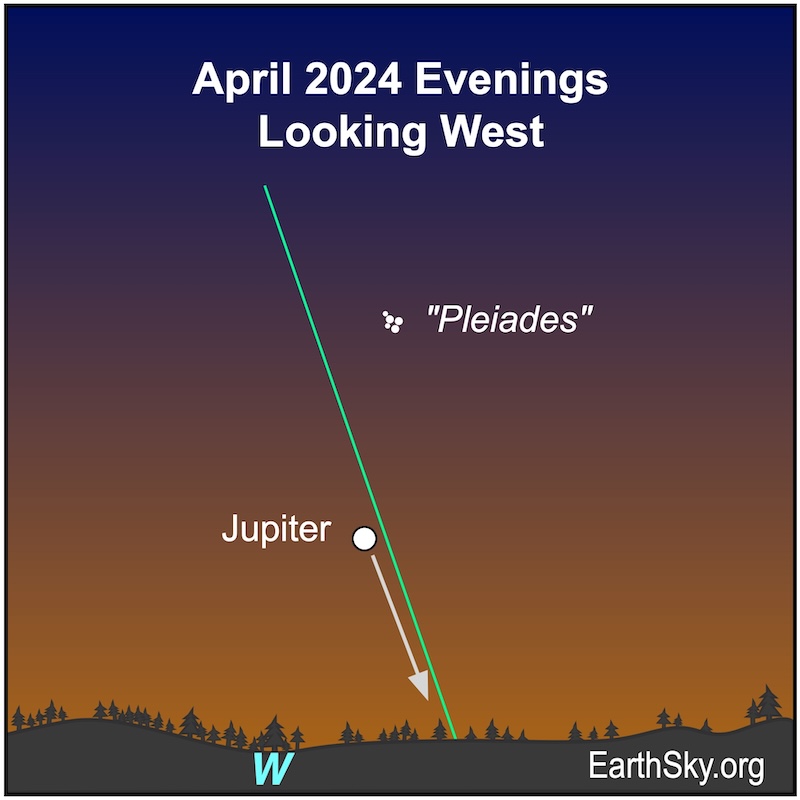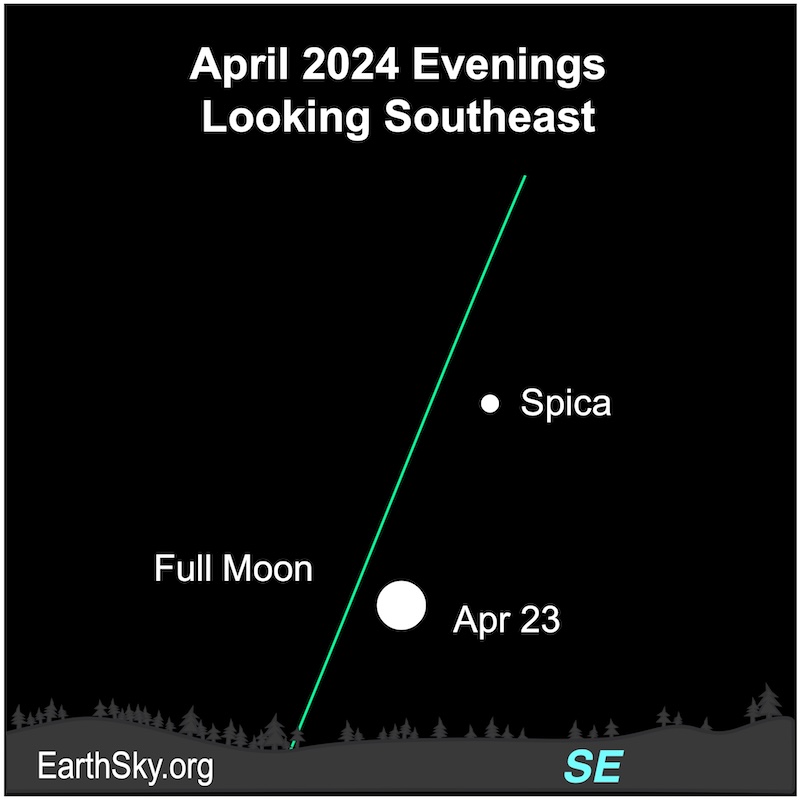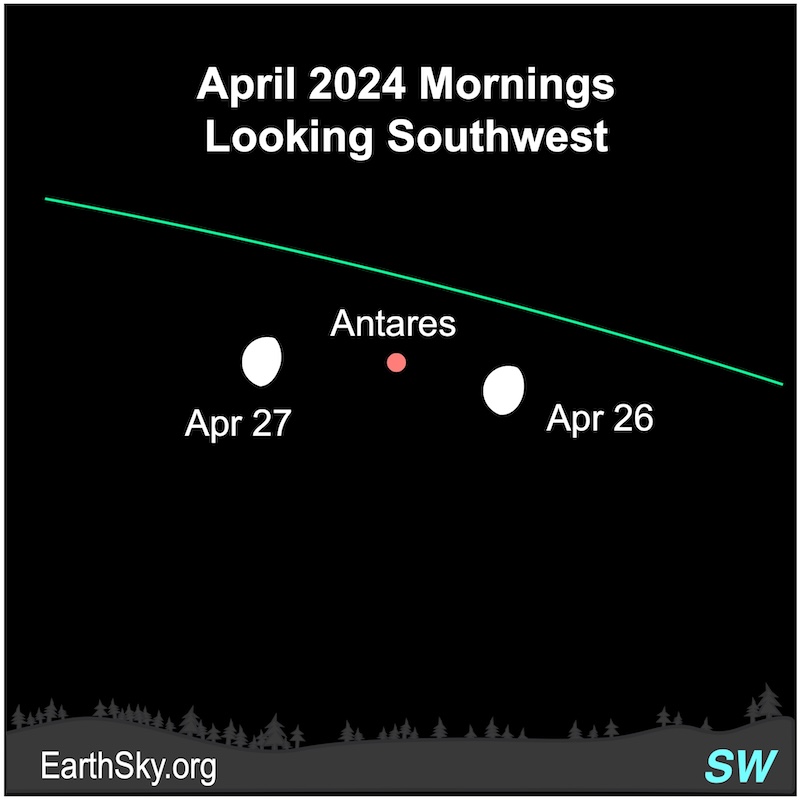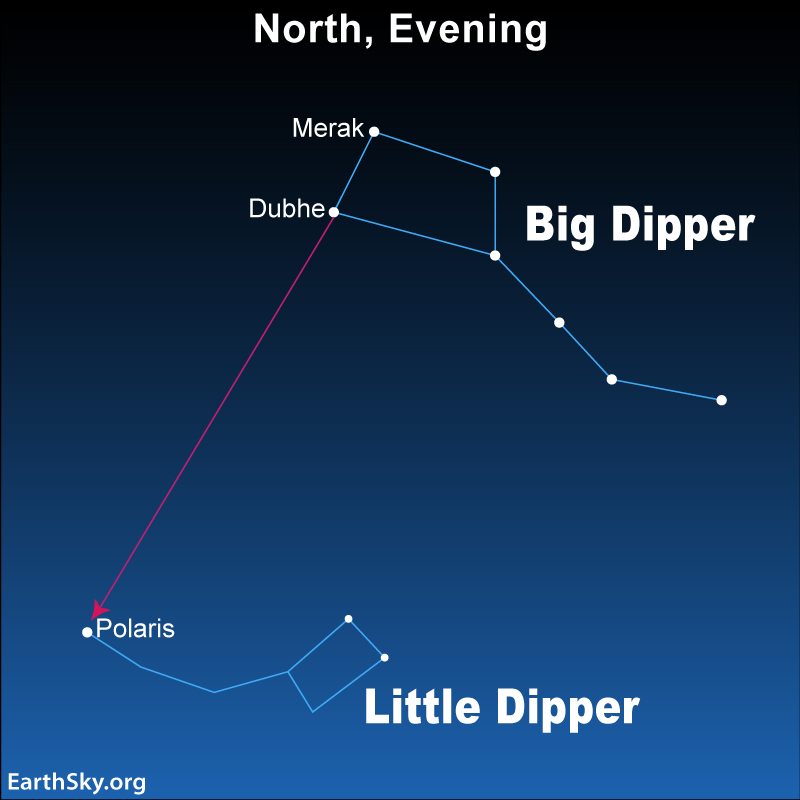
Visible Planets and Night Sky Guide for April
Originally published by EarthSky.
April 15: 1st quarter moon
The instant of 1st quarter moon will fall at 19:13 UTC on April 15, 2024 (2:13 p.m. CDT). A 1st quarter moon rises around noon your local time and sets around midnight. Watch for it high in the sky at sundown.

View at EarthSky Community Photos. | Lorraine Boyd in Glen Falls, New York, captured the 1st quarter moon on November 20, 2023. Lorraine wrote: “There’s just something about seeing the moon in the 1st quarter phase that puts a smile on my face.” Thank you, Lorraine!
April 15 evening: Moon near the twin stars of Gemini
On the evening of April 15, 2024, the first quarter moon will shine near Castor and Pollux, the twin stars of Gemini. Although they are “twin brothers,” they don’t really look alike. Pollux is a bit brighter and a golden star, while Castor shines as a white light. They’ll rise before sunset and travel across the sky’s dome before setting a few hours after midnight.

April 17 and 18 evenings: Moon near Regulus
On the evenings of April 17 and 18, 2024, the waxing gibbous moon will float near the bright star Regulus, the brightest star in Leo the Lion. They’ll be visible until a few hours before sunrise.

Moon at apogee April 20
The moon will reach apogee – its farthest distance from Earth in its elliptical orbit around Earth – at 2 UTC on April 20, 2024 (9 p.m. CDT on April 19), when it’s 252,042 miles (405,623 kilometers) away.
Overnight April 21-22: Lyrid meteor shower
Overnight tonight, the Lyrid meteor shower peaks. But the moon is nearly full, hiding all but the brightest meteors in its glare. Diehards will be watching in the moonlight. Should you? Even one bright meteor – streaking along in the glare of the bright moon – would make it all worthwhile. Tips for watching a meteor shower in moonlight here.

Lyrid meteors radiate from near the bright star Vega in the constellation Lyra the Harp. You don’t need to identify Vega or Lyra in order to watch the Lyrid meteor shower. But you do need to know when the radiant rises, in this case in the northeast before midnight. That’s why the Lyrids are typically best between midnight and dawn. You’ll see the most meteors after the radiant has come over the horizon. The meteors radiate from there but will appear unexpectedly, in any and all parts of the sky. Image via EarthSky.
April 22 evening: Moon near Spica
On the evening of April 22, 2024, the fat waxing gibbous moon will hang near the bright star Spica in Virgo the Maiden. They’ll rise before sunset and be visible until sunrise.

April evenings: Can you still see Jupiter?
For the first three months of April, Jupiter appears low in the west shortly after sunset. But during the month’s final week, it lies too low in the bright evening twilight to be easily seen. It’ll be challenging to spot.

April 23: Full moon near Spica
The full moon will glow brightly near the bright star Spica in Virgo the Maiden. The full moon occurs at 23:49 UTC (6:49 p.m. CDT) on April 23, 2024. It’ll be visible all night.

April 26 and 27 mornings: Moon near Antares
On the mornings of April 26 and 27, 2024, the waning gibbous moon will lie close to the bright star Antares in Scorpius the Scorpion. They’ll be visible from early morning until dawn. Also, skywatchers in Asia and Africa will see the moon pass in front of – or occult – Antares near 21 UTC on April 26.

The Big Dipper and Leo the Lion
April is a great time to look up overhead in the evening sky and find the well-known pattern of stars we call the Big Dipper. It’s an asterism – or obvious pattern of stars – and part of the constellation Ursa Major the Great Bear. Also, you can find the constellation Leo the Lion. Leo has another well-known asterism known as the Sickle. The Sickle looks like a backward question mark that is punctuated by the bright star Regulus. In fact, the Big Dipper can help you locate Leo and the Sickle. An imaginary line drawn southward from the pointer stars in the Big Dipper – the two outer stars in the Dipper’s bowl – points toward Leo the Lion.

The Big Dipper and Polaris
Plus, the Big Dipper can direct you to find Polaris, the North Pole Star. The two outer stars in the bowl of the Dipper point to Polaris. It’s at the end of the handle of Ursa Minor the Little Bear, commonly known as the Little Dipper. Look for the Big and Little Dippers high in the northern sky on spring evenings. This view is for the Northern Hemisphere.

Cancer the Crab
Cancer the Crab, with its Beehive star cluster, needs a dark sky to be seen. It lies between the Gemini twin stars Castor and Pollux, and the bright star Regulus in Leo the Lion.
Once you’ve found Cancer – if your sky is dark – you can see the wonderful open star cluster called the Beehive. It contains some 1,000 stars.

April evenings: Jupiter
Jupiter appears low in the west shortly after sunset in the first three weeks of April. During the month’s final week, it lies too low in the bright evening twilight to be easily seen. At the beginning of the month, Jupiter sets about three hours after sunset. At month’s end, Jupiter lies low in the evening twilight and may be challenging to spot. Jupiter will lie near the delicate Pleiades star cluster.

April mornings: Mars and Saturn
Mars and Saturn lie low in the morning twilight in April 2024. They shine with similar brightness and have a close pairing on the mornings of April 10 and 11. Saturn will climb a bit higher as the month goes on, and Mars will not move as much on the sky’s dome. By month’s end, Saturn will rise about two hours before sunrise and Mars will follow it about an hour later. Both planets will be easier to find in the coming months as they climb out of the morning glare.

Where are Venus and Mercury?
Venus is too close to the sun to be visible this month, and it’ll emerge in the evening sky around the beginning of August. Mercury will disappear from the bright evening twilight at the beginning of April and return to the morning sky in May.
Sky dome maps for visible planets and night sky
The sky dome maps come from master astronomy chart-maker Guy Ottewell. You’ll find charts like these for every month of 2024 in his Astronomical Calendar.

Here is the sky dome view for April 2024. It shows what is above the horizon at mid-evening for mid-northern latitudes. The view may vary depending on your location. Image via Guy Ottewell’s 2024 Astronomical Calendar.
Heliocentric solar system visible planets and more
The sun-centered charts come from Guy Ottewell. You’ll find charts like these for every month of 2024 in his Astronomical Calendar.

Rocket Launches can sometimes be seen in Garrett County. Especially those from Wallops Island.
Originally published by Spaceflight Now, and Time and Date.
April
April 1: Global Astronomy Month. Led by Astronomers Without Borders, a non-profit organization, the month-long event encourages people to share the sky.
April 8: A total solar eclipse takes place across Mexico, the USA, and Canada. Roughly 45 million people live along the path of totality for this eclipse.
April 8: This is the third Super New Moon in a row, and the final one for 2024. (There will be Super Full Moons in September and October.)
April 8: A United Launch Alliance Delta 4-Heavy rocket will launch a classified spy satellite cargo for the U.S. National Reconnaissance Office. The largest of the Delta 4 family, the Heavy version features three Common Booster Cores mounted together to form a triple-body rocket. This is the final flight of a Delta 4 rocket. Delayed from March 28.
April 21/22: The Lyrid meteor shower is expected to peak around April 21 and 22, depending on your location.
April 23: April’s Full Moon is traditionally known as the Pink Full Moon.





